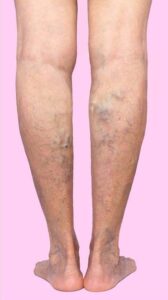Is varicose vein really harmful? Does it need to be treated?
 Varicose veins are common, and if you have them, they may not cause you too much trouble. Sure, they’re unsightly, but for many people, they’re not particularly painful. Even if they are uncomfortable, are they really harmful? Do your varicose veins need to be treated?
Varicose veins are common, and if you have them, they may not cause you too much trouble. Sure, they’re unsightly, but for many people, they’re not particularly painful. Even if they are uncomfortable, are they really harmful? Do your varicose veins need to be treated?
In most cases, varicose veins are not dangerous. They are the result of faulty valves in the veins that allow blood to flow backward and pool in the veins. Though they can cause symptoms: pain, tenderness, swelling, and weakness, loss of body part or life is not generally a side effect of varicose veins. However, even though complications are rare, they can be extremely serious.
- Potentially, you might end up with bursting veins. External bleeding can happen when bulging, swollen varicose veins are bumped into something blunt or punctured by something sharp. In fact, sometimes varicose veins can bleed spontaneously, even if there’s no apparent trauma. Sometimes, when people are in the shower, the hot water creates increased pressure in the vein that causes it to rupture. If this happens to you, apply pressure for at least five to ten minutes, then seek medical treatment. A doctor can suture or glue the vein, to prevent it from rebleeding. Sometimes, a pressure bandage may be the appropriate treatment. Often, the doctor will advise someone with a burst vein to seek treatment for the underlying condition.
- Another danger with varicose veins is blood clots. In surface veins, these blood clots are typically not dangerous, but just cause the area to be red, warm, firm, and tender. This is because the body is responding to the superficial blood clot with inflammation. In some cases, however, these superficial blood clots extend into the deeper veins in the legs, resulting in deep vein thrombosis. This causes pain and swelling, but it also brings with it a risk of a pulmonary embolism, which can be extremely serious.
- Untreated varicose veins can become more uncomfortable and potentially harmful. They can cause you to develop stasis dermatitis, which dries the skin and makes it itch. You might experience additional pain and swelling, weakness in the legs, and even ulcers. These unfortunate symptoms are in addition to potentially deadly conditions like deep vein thrombosis and blood clots, and lipodermatosclerosis, an inflammatory condition that causes the skin to harden.
Fortunately, there are safe, effective, non-invasive treatments available for varicose veins. The veins can be sealed, either using injections or laser therapy. They can also be removed, through microphlebectomy. Each of these treatments can be performed in your healthcare provider’s office, with very little downtime.
So, do you need treatment for your varicose veins? Talk to a vein specialist to decide what’s right for you. If you’re looking for the very best care for your vein and blood flow issues, trust the board-certified physicians at the Arizona Vein & Laser Institute. Using the most advanced technology, the vascular and cardiovascular surgeons at the Arizona Vein & Laser Institute provide care for all types of venous diseases. With over 40 years of experience, our team of experienced physicians can devise the right treatment plan to address your venous disease problems. For more information contact us through our website.
